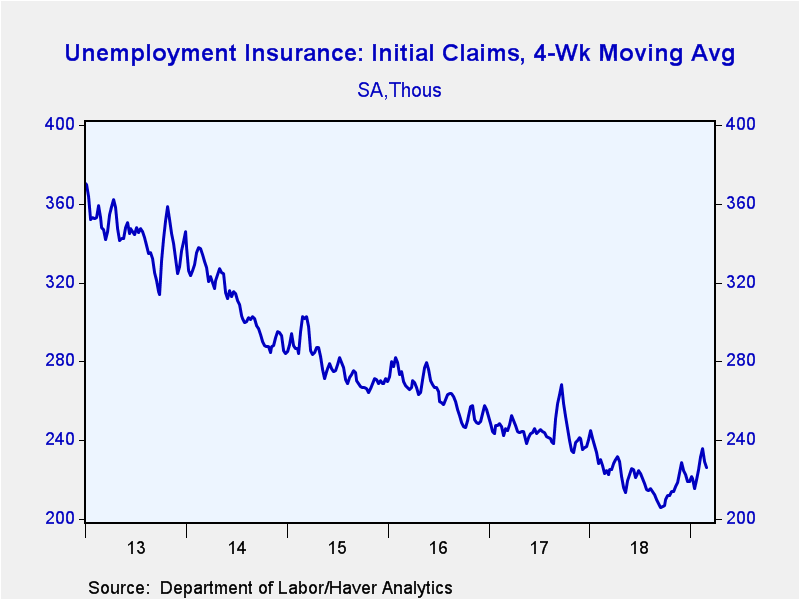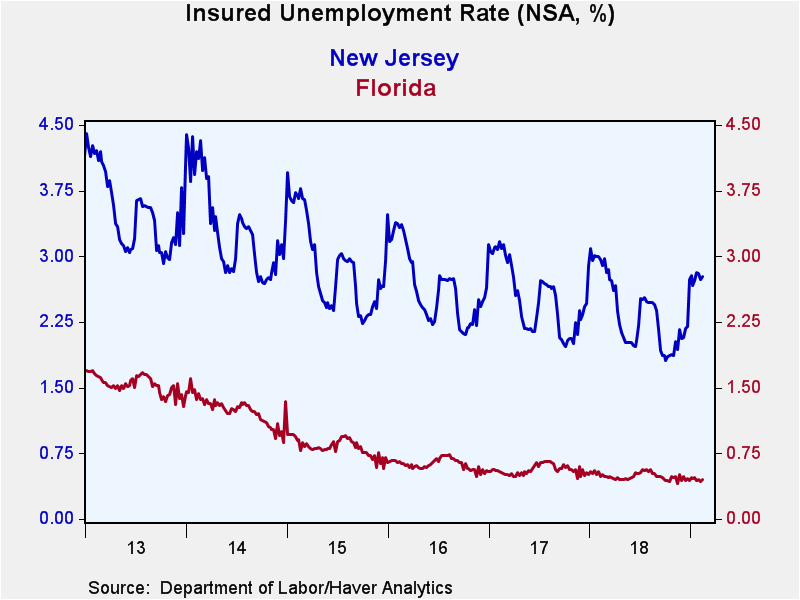 Global| Mar 07 2019
Global| Mar 07 2019U.S. Initial Unemployment Insurance Claims Edge Down
by:Sandy Batten
|in:Economy in Brief
Summary
Initial claims for unemployment insurance were 225,000 in the week ended February 23... Continuing claims for unemployment insurance rose to 1.805 million in the February 16 week........... Initial claims for unemployment insurance [...]
Initial claims for unemployment insurance were 225,000 in the week ended February 23... Continuing claims for unemployment insurance rose to 1.805 million in the February 16 week...........
Initial claims for unemployment insurance edged down to 223,000 in the week ended March 2 from an upwardly revised 226,000 (initially reported as 225,000) in the previous week. The Action Economics Forecast Survey projected 225,000 claims for this week. The four-week moving average of initial claims fell further to 226,250 from 229,250 the previous week. Notwithstanding the recent decline, claims appear to be trending gradually upward since the middle of last September. Continuing claims for unemployment insurance receded to 1.755 million in the week ended February 23 after having risen to a 44-week high of 1.805 million (not revised) in the previous week. With the decline in the number of continuing claims, the insured unemployment rate—continuing claims as a percent of covered employment—fell back to 1.2% in the week ended February 23 from 1.3% in the previous week. Prior to the increase to 1.3%, this rate had fluctuated between 1.1% and 1.2% for the preceding 9-1/2 months with 1.1% a record low for this series which spans 48 years. (These statistics are reported with a one-week lag relative to the headline claims figure.) In a separate program, one that acquired quite a bit of interest during the federal government shutdown, the number of federal government workers filing initial claims fell again in the latest reading to 658 (not seasonally adjusted) in the week ended February 23, down from 787 the prior week. During the shutdown, this figure had ballooned to more than 25,000. Insured unemployment rates vary widely by state. These state data are not seasonally adjusted and are reported with a two-week lag to the headline claims figure. In the week ending February 16, the lowest rates were in Florida (0.45%), North Carolina (0.50%), Tennessee (0.61%), Georgia (0.63%) and Virginia (0.63%). The highest rates were in Alaska (3.32%), New Jersey (2.77%), Montana (2.66%), Rhode Island (2.56%) and Connecticut (2.55%). Rates in other states with large populations include California (2.27%), Texas (0.99%), New York (1.74%), Pennsylvania (2.46%) and Illinois (2.28%). Data on weekly unemployment claims going back to 1967 are contained in Haver’s WEEKLY database and are summarized monthly in USECON. Data for individual states are in REGIONW. The expectations figure is from the Action Economics Forecast Survey, carried in the AS1REPNA database. Data on weekly unemployment claims going back to 1967 are contained in Haver's WEEKLY database and are summarized monthly in USECON. Data for individual states are in REGIONW. The expectations figure is from the Action Economics Forecast Survey, carried in the AS1REPNA database.
| Unemployment Insurance (SA, 000s) | 02/23/19 | 02/16/19 | 02/09/19 | Y/Y % | 2018 | 2017 | 2016 |
|---|---|---|---|---|---|---|---|
| Initial Claims | 225 | 217 | 239 | 3.7 | 221 | 244 | 262 |
| Continuing Claims | -- | 1,805 | 1,726 | -6.1 | 1,766 | 1,967 | 2,135 |
| Insured Unemployment Rate (%) | -- | 1.3 | 1.2 |
1.3 |
1.2 | 1.4 | 1.6 |
Sandy Batten
AuthorMore in Author Profile »Sandy Batten has more than 30 years of experience analyzing industrial economies and financial markets and a wide range of experience across the financial services sector, government, and academia. Before joining Haver Analytics, Sandy was a Vice President and Senior Economist at Citibank; Senior Credit Market Analyst at CDC Investment Management, Managing Director at Bear Stearns, and Executive Director at JPMorgan. In 2008, Sandy was named the most accurate US forecaster by the National Association for Business Economics. He is a member of the New York Forecasters Club, NABE, and the American Economic Association. Prior to his time in the financial services sector, Sandy was a Research Officer at the Federal Reserve Bank of St. Louis, Senior Staff Economist on the President’s Council of Economic Advisors, Deputy Assistant Secretary for Economic Policy at the US Treasury, and Economist at the International Monetary Fund. Sandy has taught economics at St. Louis University, Denison University, and Muskingun College. He has published numerous peer-reviewed articles in a wide range of academic publications. He has a B.A. in economics from the University of Richmond and a M.A. and Ph.D. in economics from The Ohio State University.










